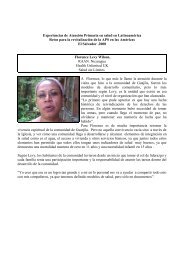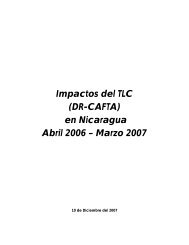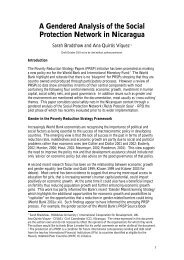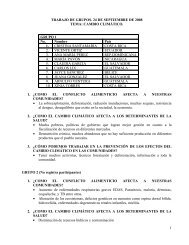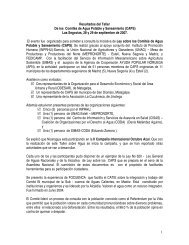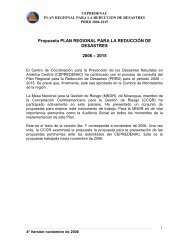Download - CISAS | Centro de Información y Servicios de AsesorÃa ...
Download - CISAS | Centro de Información y Servicios de AsesorÃa ...
Download - CISAS | Centro de Información y Servicios de AsesorÃa ...
Create successful ePaper yourself
Turn your PDF publications into a flip-book with our unique Google optimized e-Paper software.
INFORME ALTERNATIVO SOBRE LA SALUD EN AMERICA LATINAState-Society correlation and social institutions whichoverlapped with them; from another perspective, theclass bias, which differentiated them, left its mark onsocial policies, especially those related to health.The discrimination between workers and employees,instituted with Social Security, gave rise to a historicstruggle, led, since the 30’s, by the socialist doctorSalvador Allen<strong>de</strong>. He was minister in the social governmentera (1939-1941), notable parliamentarian,and Presi<strong>de</strong>nt of the Republic (1970). Allen<strong>de</strong> pursuedthe integration of the social previsional funds or theunification of all health services in one institution, andthe rectification of geographical and class disparity.Allen<strong>de</strong> believed that health iwas a universal right andthat health status is <strong>de</strong>termined primarily by factorssuch as proper wages, housing, nutrition, education, leisureand culture [Allen<strong>de</strong>, 1939].The disputes aroundthese issues emerged strongly during the "Socialist Republic"halfway through 1932.This occurred when progressivecurrents strove for socio-economical transformationsalong with medical groups that, influencedby the soviet health system, <strong>de</strong>fen<strong>de</strong>d the disseminationof "sanitary factories" ("usinas") throughout thecountry. The objective was to form a universal, integrated,efficient and humane organization, directed bya "technical commanding group", with centralized planningas its main instrument.In the health sphere, these events re-created thehistoric struggle between three i<strong>de</strong>ological currentsthat divi<strong>de</strong>d professionals and whose vestiges still persist:the right or conservative wing, <strong>de</strong>fen<strong>de</strong>r of statemedical assistance for the poor and the needy; thecenter wing, favorable to the maintenance of provisionof medical assistance separated from public health; andthe left wing, partisan of a unique system of health, integratedand universal, inspired by social medicineprinciples. In the interim, the legal reforms of the systemof social protection resulted in a hybrid of thesepositions, due to the State of compromise.The <strong>de</strong>mands for more equitable social policieswere partially acknowledged when, after eleven yearsof legislative transaction, the unification of the pensionfunds brought about the modification of the regime ofbenefits of Social Security in 1952. As part of the samelaw, by means of parliamentary artifices, an article wasimplemented that merged all the medical and hospitalservices and the jurisdictions of public health of thecountry in one institution – the National Health Service("Servicio Nacional <strong>de</strong> Salud", SNS), inspired by theNational Health Service (NHS) created in 1948 in capitalistEngland, financed by the Treasure, and whosecoverage was universal. Nevertheless, this intention ofimitating the NHS was abridged as the SNS remained apart of the Social Security and, as such, was subjectedto the same financial limitations, with restrictive coveragefor the urban workers. Consequently, the relationshipof the conjuncture revealed the power of thelandowners (right-wing) system upon impeding the inclusionof peasants, and of the center wing on opposingthe leveling of workers and employees. Thus, the healthcoverage was preserved for the urban workers withtheir <strong>de</strong>pen<strong>de</strong>nts and for indigents who could certifythis condition. In spite of this, it should be stated thatthe SNS was a pioneer in Latin America, a paradigm forits institutional engineering, its technical competenceand territorial organization in "health zones"; for theadoption of new planning and programming methodsand for the excellence of its leading members (all ofthem educated at the Sanitary School, created in 1943).In addition to these events, the foundation of theMedical School in 1948 had an effect (presi<strong>de</strong>d over byAllen<strong>de</strong>). This institution gained monopolistic representationof the profession, the exclusive ethical piercontrol and the rest of prerogatives of public status,turning into a crucial national and sectorial actor. Attributableto this corporative power, doctors wereable to negotiate a privileged statute by which theywere converted into civil servants.24





